CQUniversity Project Plan: NAIDOC Week Celebration & Management
VerifiedAdded on 2024/05/29
|22
|4872
|162
Project
AI Summary
This project plan outlines the organization and management of CQUniversity's NAIDOC Week Celebration, in collaboration with the National Aborigines and Islanders Day Observance Committee (NAIDOC). The project aims to celebrate the history, culture, and achievements of Aboriginal and Torres Strait Islander communities. It includes various activities and competitions, focusing on the theme ‘Because of her, we can’. The plan details project justification, stakeholder engagement, communication strategies, and requirements management, including engaging with traditional land owners. Stakeholder analysis includes identifying key stakeholders, assessing their engagement levels, and defining communication methods using push and pull techniques. The document emphasizes collaborative relationships, cultural awareness, and the practical application of project management protocols, aiming for a successful and academically beneficial event.
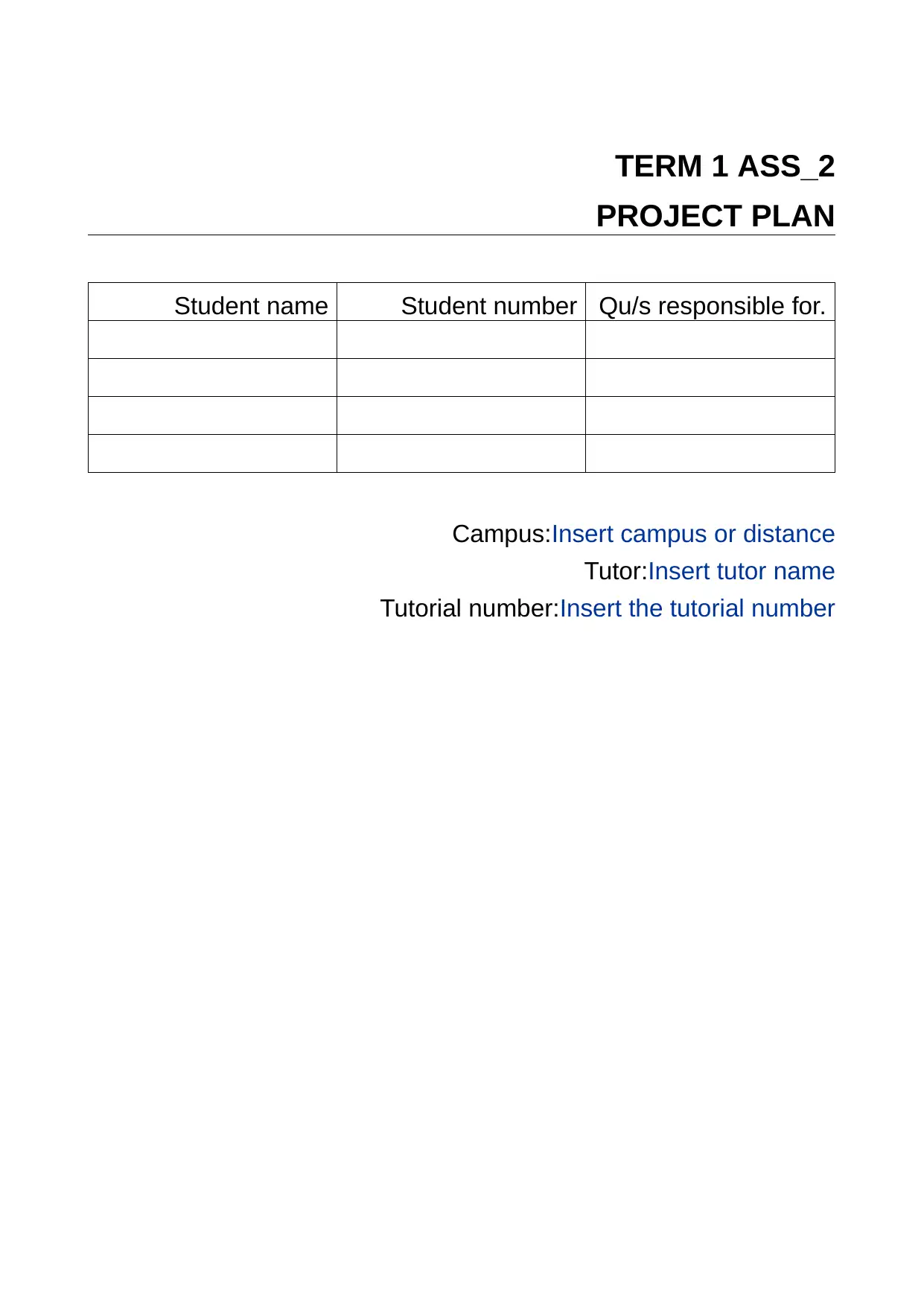
TERM 1 ASS_2
PROJECT PLAN
Student name Student number Qu/s responsible for.
Campus:Insert campus or distance
Tutor:Insert tutor name
Tutorial number:Insert the tutorial number
PROJECT PLAN
Student name Student number Qu/s responsible for.
Campus:Insert campus or distance
Tutor:Insert tutor name
Tutorial number:Insert the tutorial number
Paraphrase This Document
Need a fresh take? Get an instant paraphrase of this document with our AI Paraphraser


⊘ This is a preview!⊘
Do you want full access?
Subscribe today to unlock all pages.

Trusted by 1+ million students worldwide
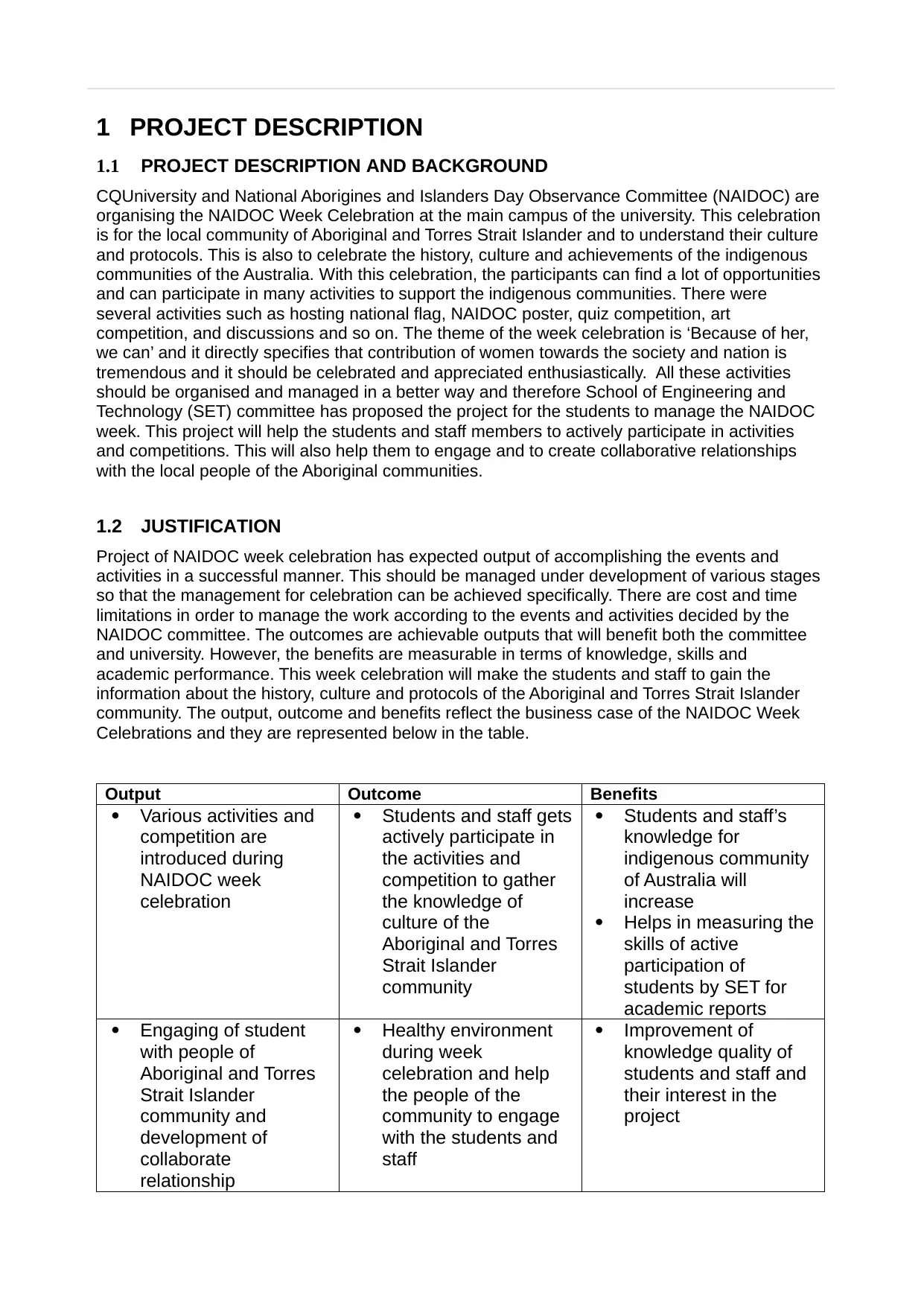
1 PROJECT DESCRIPTION
1.1 PROJECT DESCRIPTION AND BACKGROUND
CQUniversity and National Aborigines and Islanders Day Observance Committee (NAIDOC) are
organising the NAIDOC Week Celebration at the main campus of the university. This celebration
is for the local community of Aboriginal and Torres Strait Islander and to understand their culture
and protocols. This is also to celebrate the history, culture and achievements of the indigenous
communities of the Australia. With this celebration, the participants can find a lot of opportunities
and can participate in many activities to support the indigenous communities. There were
several activities such as hosting national flag, NAIDOC poster, quiz competition, art
competition, and discussions and so on. The theme of the week celebration is ‘Because of her,
we can’ and it directly specifies that contribution of women towards the society and nation is
tremendous and it should be celebrated and appreciated enthusiastically. All these activities
should be organised and managed in a better way and therefore School of Engineering and
Technology (SET) committee has proposed the project for the students to manage the NAIDOC
week. This project will help the students and staff members to actively participate in activities
and competitions. This will also help them to engage and to create collaborative relationships
with the local people of the Aboriginal communities.
1.2 JUSTIFICATION
Project of NAIDOC week celebration has expected output of accomplishing the events and
activities in a successful manner. This should be managed under development of various stages
so that the management for celebration can be achieved specifically. There are cost and time
limitations in order to manage the work according to the events and activities decided by the
NAIDOC committee. The outcomes are achievable outputs that will benefit both the committee
and university. However, the benefits are measurable in terms of knowledge, skills and
academic performance. This week celebration will make the students and staff to gain the
information about the history, culture and protocols of the Aboriginal and Torres Strait Islander
community. The output, outcome and benefits reflect the business case of the NAIDOC Week
Celebrations and they are represented below in the table.
Output Outcome Benefits
Various activities and
competition are
introduced during
NAIDOC week
celebration
Students and staff gets
actively participate in
the activities and
competition to gather
the knowledge of
culture of the
Aboriginal and Torres
Strait Islander
community
Students and staff’s
knowledge for
indigenous community
of Australia will
increase
Helps in measuring the
skills of active
participation of
students by SET for
academic reports
Engaging of student
with people of
Aboriginal and Torres
Strait Islander
community and
development of
collaborate
relationship
Healthy environment
during week
celebration and help
the people of the
community to engage
with the students and
staff
Improvement of
knowledge quality of
students and staff and
their interest in the
project
1.1 PROJECT DESCRIPTION AND BACKGROUND
CQUniversity and National Aborigines and Islanders Day Observance Committee (NAIDOC) are
organising the NAIDOC Week Celebration at the main campus of the university. This celebration
is for the local community of Aboriginal and Torres Strait Islander and to understand their culture
and protocols. This is also to celebrate the history, culture and achievements of the indigenous
communities of the Australia. With this celebration, the participants can find a lot of opportunities
and can participate in many activities to support the indigenous communities. There were
several activities such as hosting national flag, NAIDOC poster, quiz competition, art
competition, and discussions and so on. The theme of the week celebration is ‘Because of her,
we can’ and it directly specifies that contribution of women towards the society and nation is
tremendous and it should be celebrated and appreciated enthusiastically. All these activities
should be organised and managed in a better way and therefore School of Engineering and
Technology (SET) committee has proposed the project for the students to manage the NAIDOC
week. This project will help the students and staff members to actively participate in activities
and competitions. This will also help them to engage and to create collaborative relationships
with the local people of the Aboriginal communities.
1.2 JUSTIFICATION
Project of NAIDOC week celebration has expected output of accomplishing the events and
activities in a successful manner. This should be managed under development of various stages
so that the management for celebration can be achieved specifically. There are cost and time
limitations in order to manage the work according to the events and activities decided by the
NAIDOC committee. The outcomes are achievable outputs that will benefit both the committee
and university. However, the benefits are measurable in terms of knowledge, skills and
academic performance. This week celebration will make the students and staff to gain the
information about the history, culture and protocols of the Aboriginal and Torres Strait Islander
community. The output, outcome and benefits reflect the business case of the NAIDOC Week
Celebrations and they are represented below in the table.
Output Outcome Benefits
Various activities and
competition are
introduced during
NAIDOC week
celebration
Students and staff gets
actively participate in
the activities and
competition to gather
the knowledge of
culture of the
Aboriginal and Torres
Strait Islander
community
Students and staff’s
knowledge for
indigenous community
of Australia will
increase
Helps in measuring the
skills of active
participation of
students by SET for
academic reports
Engaging of student
with people of
Aboriginal and Torres
Strait Islander
community and
development of
collaborate
relationship
Healthy environment
during week
celebration and help
the people of the
community to engage
with the students and
staff
Improvement of
knowledge quality of
students and staff and
their interest in the
project
Paraphrase This Document
Need a fresh take? Get an instant paraphrase of this document with our AI Paraphraser
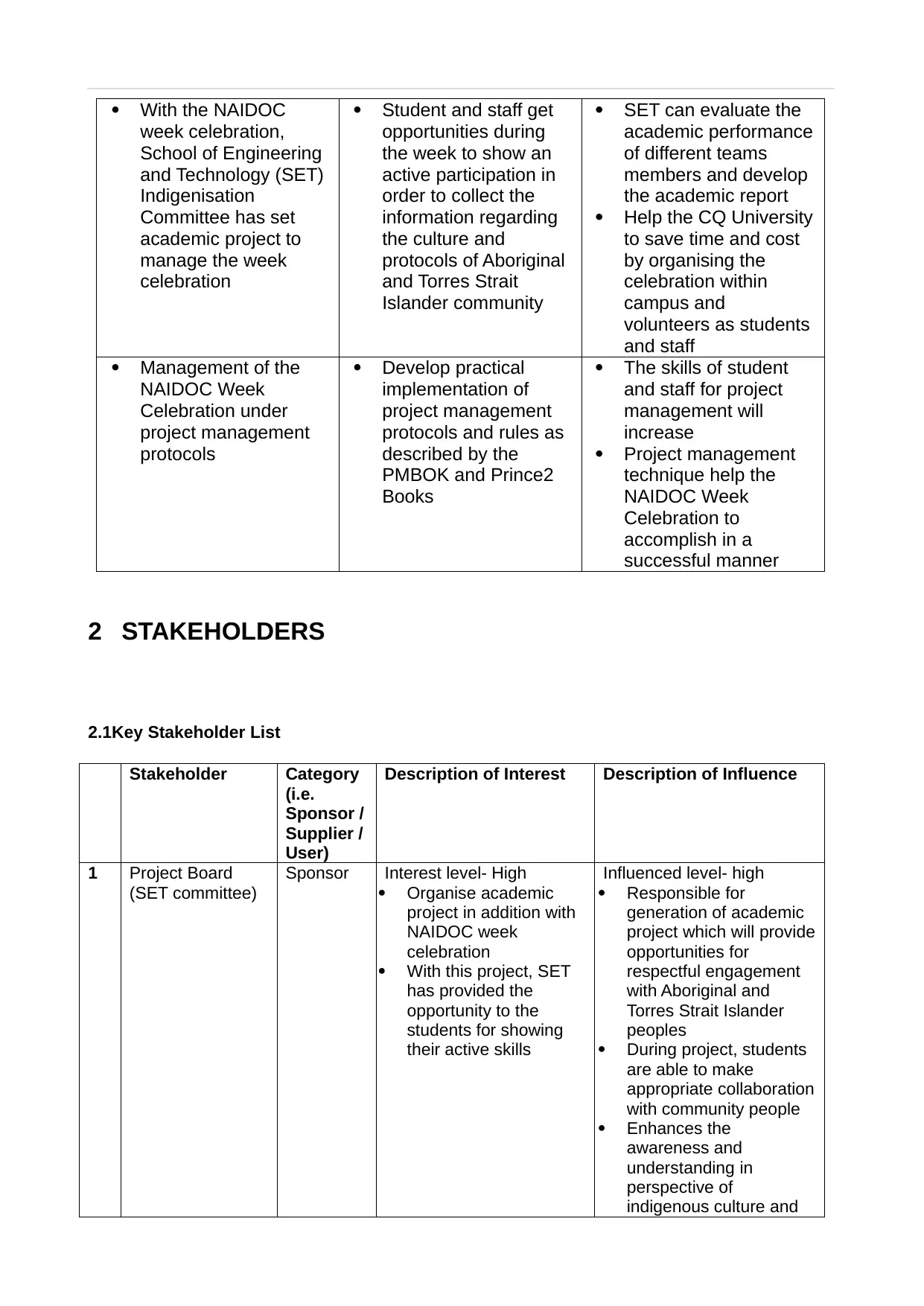
With the NAIDOC
week celebration,
School of Engineering
and Technology (SET)
Indigenisation
Committee has set
academic project to
manage the week
celebration
Student and staff get
opportunities during
the week to show an
active participation in
order to collect the
information regarding
the culture and
protocols of Aboriginal
and Torres Strait
Islander community
SET can evaluate the
academic performance
of different teams
members and develop
the academic report
Help the CQ University
to save time and cost
by organising the
celebration within
campus and
volunteers as students
and staff
Management of the
NAIDOC Week
Celebration under
project management
protocols
Develop practical
implementation of
project management
protocols and rules as
described by the
PMBOK and Prince2
Books
The skills of student
and staff for project
management will
increase
Project management
technique help the
NAIDOC Week
Celebration to
accomplish in a
successful manner
2 STAKEHOLDERS
2.1Key Stakeholder List
Stakeholder Category
(i.e.
Sponsor /
Supplier /
User)
Description of Interest Description of Influence
1 Project Board
(SET committee)
Sponsor Interest level- High
Organise academic
project in addition with
NAIDOC week
celebration
With this project, SET
has provided the
opportunity to the
students for showing
their active skills
Influenced level- high
Responsible for
generation of academic
project which will provide
opportunities for
respectful engagement
with Aboriginal and
Torres Strait Islander
peoples
During project, students
are able to make
appropriate collaboration
with community people
Enhances the
awareness and
understanding in
perspective of
indigenous culture and
week celebration,
School of Engineering
and Technology (SET)
Indigenisation
Committee has set
academic project to
manage the week
celebration
Student and staff get
opportunities during
the week to show an
active participation in
order to collect the
information regarding
the culture and
protocols of Aboriginal
and Torres Strait
Islander community
SET can evaluate the
academic performance
of different teams
members and develop
the academic report
Help the CQ University
to save time and cost
by organising the
celebration within
campus and
volunteers as students
and staff
Management of the
NAIDOC Week
Celebration under
project management
protocols
Develop practical
implementation of
project management
protocols and rules as
described by the
PMBOK and Prince2
Books
The skills of student
and staff for project
management will
increase
Project management
technique help the
NAIDOC Week
Celebration to
accomplish in a
successful manner
2 STAKEHOLDERS
2.1Key Stakeholder List
Stakeholder Category
(i.e.
Sponsor /
Supplier /
User)
Description of Interest Description of Influence
1 Project Board
(SET committee)
Sponsor Interest level- High
Organise academic
project in addition with
NAIDOC week
celebration
With this project, SET
has provided the
opportunity to the
students for showing
their active skills
Influenced level- high
Responsible for
generation of academic
project which will provide
opportunities for
respectful engagement
with Aboriginal and
Torres Strait Islander
peoples
During project, students
are able to make
appropriate collaboration
with community people
Enhances the
awareness and
understanding in
perspective of
indigenous culture and
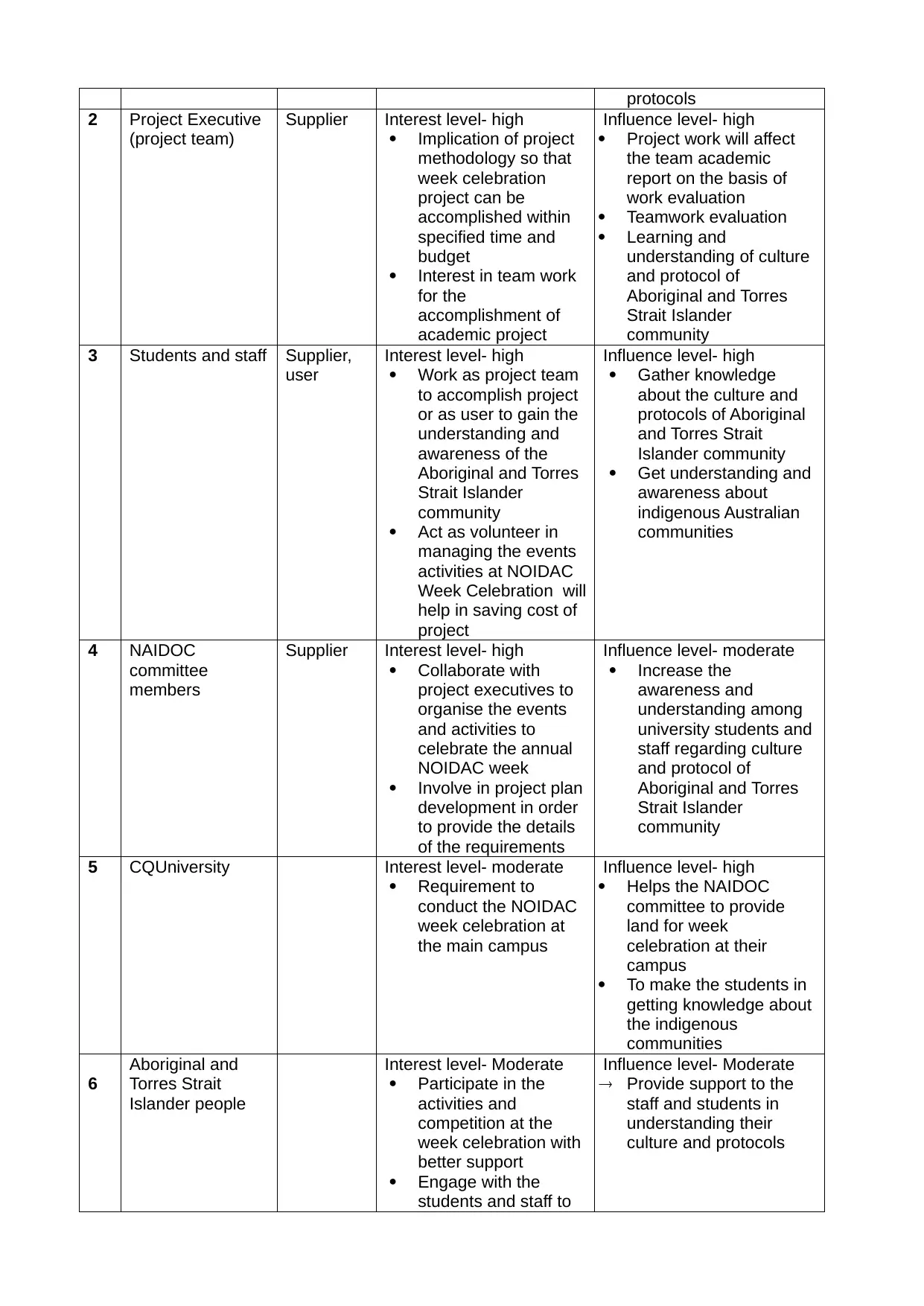
protocols
2 Project Executive
(project team)
Supplier Interest level- high
Implication of project
methodology so that
week celebration
project can be
accomplished within
specified time and
budget
Interest in team work
for the
accomplishment of
academic project
Influence level- high
Project work will affect
the team academic
report on the basis of
work evaluation
Teamwork evaluation
Learning and
understanding of culture
and protocol of
Aboriginal and Torres
Strait Islander
community
3 Students and staff Supplier,
user
Interest level- high
Work as project team
to accomplish project
or as user to gain the
understanding and
awareness of the
Aboriginal and Torres
Strait Islander
community
Act as volunteer in
managing the events
activities at NOIDAC
Week Celebration will
help in saving cost of
project
Influence level- high
Gather knowledge
about the culture and
protocols of Aboriginal
and Torres Strait
Islander community
Get understanding and
awareness about
indigenous Australian
communities
4 NAIDOC
committee
members
Supplier Interest level- high
Collaborate with
project executives to
organise the events
and activities to
celebrate the annual
NOIDAC week
Involve in project plan
development in order
to provide the details
of the requirements
Influence level- moderate
Increase the
awareness and
understanding among
university students and
staff regarding culture
and protocol of
Aboriginal and Torres
Strait Islander
community
5 CQUniversity Interest level- moderate
Requirement to
conduct the NOIDAC
week celebration at
the main campus
Influence level- high
Helps the NAIDOC
committee to provide
land for week
celebration at their
campus
To make the students in
getting knowledge about
the indigenous
communities
6
Aboriginal and
Torres Strait
Islander people
Interest level- Moderate
Participate in the
activities and
competition at the
week celebration with
better support
Engage with the
students and staff to
Influence level- Moderate
Provide support to the
staff and students in
understanding their
culture and protocols
2 Project Executive
(project team)
Supplier Interest level- high
Implication of project
methodology so that
week celebration
project can be
accomplished within
specified time and
budget
Interest in team work
for the
accomplishment of
academic project
Influence level- high
Project work will affect
the team academic
report on the basis of
work evaluation
Teamwork evaluation
Learning and
understanding of culture
and protocol of
Aboriginal and Torres
Strait Islander
community
3 Students and staff Supplier,
user
Interest level- high
Work as project team
to accomplish project
or as user to gain the
understanding and
awareness of the
Aboriginal and Torres
Strait Islander
community
Act as volunteer in
managing the events
activities at NOIDAC
Week Celebration will
help in saving cost of
project
Influence level- high
Gather knowledge
about the culture and
protocols of Aboriginal
and Torres Strait
Islander community
Get understanding and
awareness about
indigenous Australian
communities
4 NAIDOC
committee
members
Supplier Interest level- high
Collaborate with
project executives to
organise the events
and activities to
celebrate the annual
NOIDAC week
Involve in project plan
development in order
to provide the details
of the requirements
Influence level- moderate
Increase the
awareness and
understanding among
university students and
staff regarding culture
and protocol of
Aboriginal and Torres
Strait Islander
community
5 CQUniversity Interest level- moderate
Requirement to
conduct the NOIDAC
week celebration at
the main campus
Influence level- high
Helps the NAIDOC
committee to provide
land for week
celebration at their
campus
To make the students in
getting knowledge about
the indigenous
communities
6
Aboriginal and
Torres Strait
Islander people
Interest level- Moderate
Participate in the
activities and
competition at the
week celebration with
better support
Engage with the
students and staff to
Influence level- Moderate
Provide support to the
staff and students in
understanding their
culture and protocols
⊘ This is a preview!⊘
Do you want full access?
Subscribe today to unlock all pages.

Trusted by 1+ million students worldwide
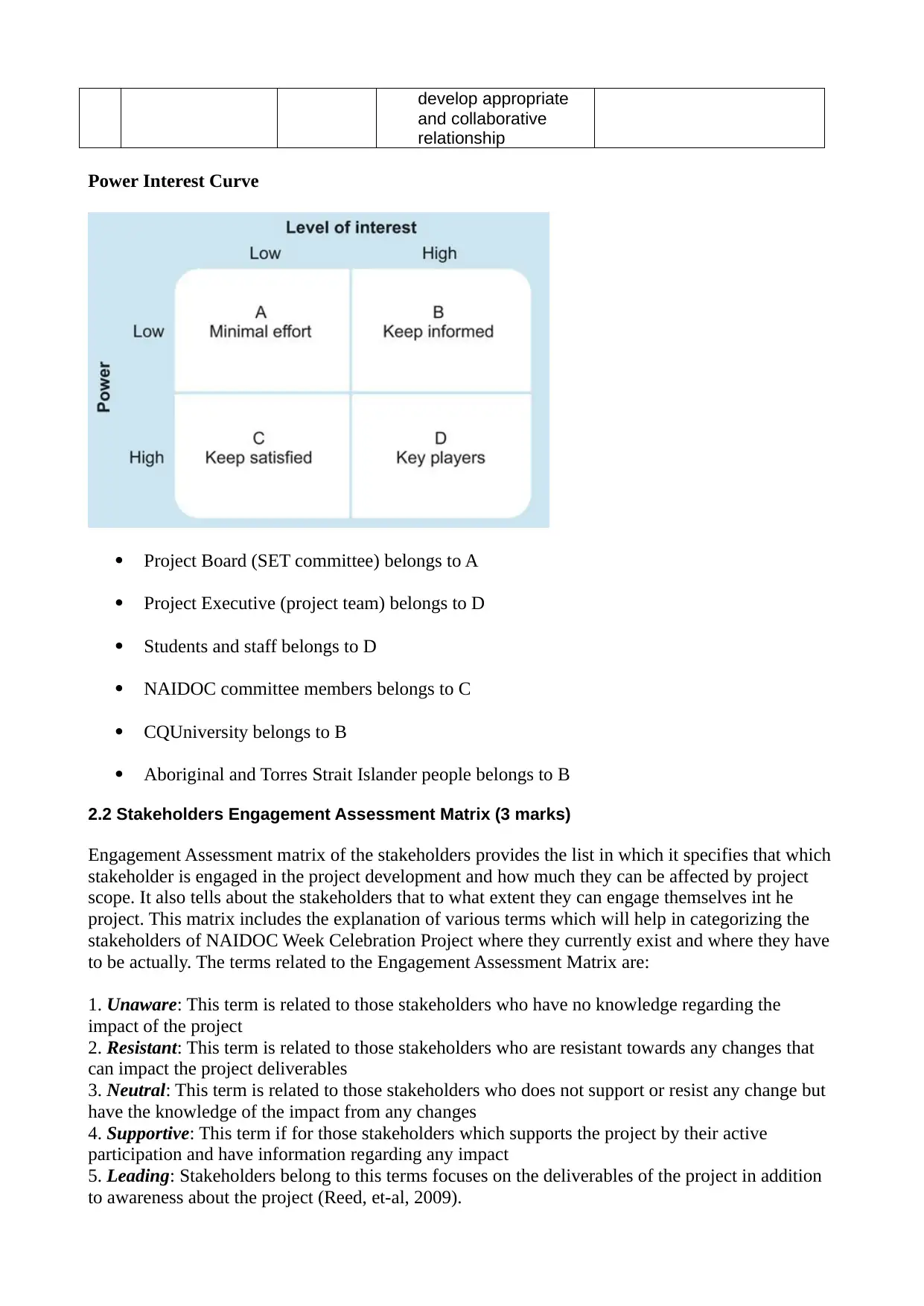
develop appropriate
and collaborative
relationship
Power Interest Curve
Project Board (SET committee) belongs to A
Project Executive (project team) belongs to D
Students and staff belongs to D
NAIDOC committee members belongs to C
CQUniversity belongs to B
Aboriginal and Torres Strait Islander people belongs to B
2.2 Stakeholders Engagement Assessment Matrix (3 marks)
Engagement Assessment matrix of the stakeholders provides the list in which it specifies that which
stakeholder is engaged in the project development and how much they can be affected by project
scope. It also tells about the stakeholders that to what extent they can engage themselves int he
project. This matrix includes the explanation of various terms which will help in categorizing the
stakeholders of NAIDOC Week Celebration Project where they currently exist and where they have
to be actually. The terms related to the Engagement Assessment Matrix are:
1. Unaware: This term is related to those stakeholders who have no knowledge regarding the
impact of the project
2. Resistant: This term is related to those stakeholders who are resistant towards any changes that
can impact the project deliverables
3. Neutral: This term is related to those stakeholders who does not support or resist any change but
have the knowledge of the impact from any changes
4. Supportive: This term if for those stakeholders which supports the project by their active
participation and have information regarding any impact
5. Leading: Stakeholders belong to this terms focuses on the deliverables of the project in addition
to awareness about the project (Reed, et-al, 2009).
and collaborative
relationship
Power Interest Curve
Project Board (SET committee) belongs to A
Project Executive (project team) belongs to D
Students and staff belongs to D
NAIDOC committee members belongs to C
CQUniversity belongs to B
Aboriginal and Torres Strait Islander people belongs to B
2.2 Stakeholders Engagement Assessment Matrix (3 marks)
Engagement Assessment matrix of the stakeholders provides the list in which it specifies that which
stakeholder is engaged in the project development and how much they can be affected by project
scope. It also tells about the stakeholders that to what extent they can engage themselves int he
project. This matrix includes the explanation of various terms which will help in categorizing the
stakeholders of NAIDOC Week Celebration Project where they currently exist and where they have
to be actually. The terms related to the Engagement Assessment Matrix are:
1. Unaware: This term is related to those stakeholders who have no knowledge regarding the
impact of the project
2. Resistant: This term is related to those stakeholders who are resistant towards any changes that
can impact the project deliverables
3. Neutral: This term is related to those stakeholders who does not support or resist any change but
have the knowledge of the impact from any changes
4. Supportive: This term if for those stakeholders which supports the project by their active
participation and have information regarding any impact
5. Leading: Stakeholders belong to this terms focuses on the deliverables of the project in addition
to awareness about the project (Reed, et-al, 2009).
Paraphrase This Document
Need a fresh take? Get an instant paraphrase of this document with our AI Paraphraser
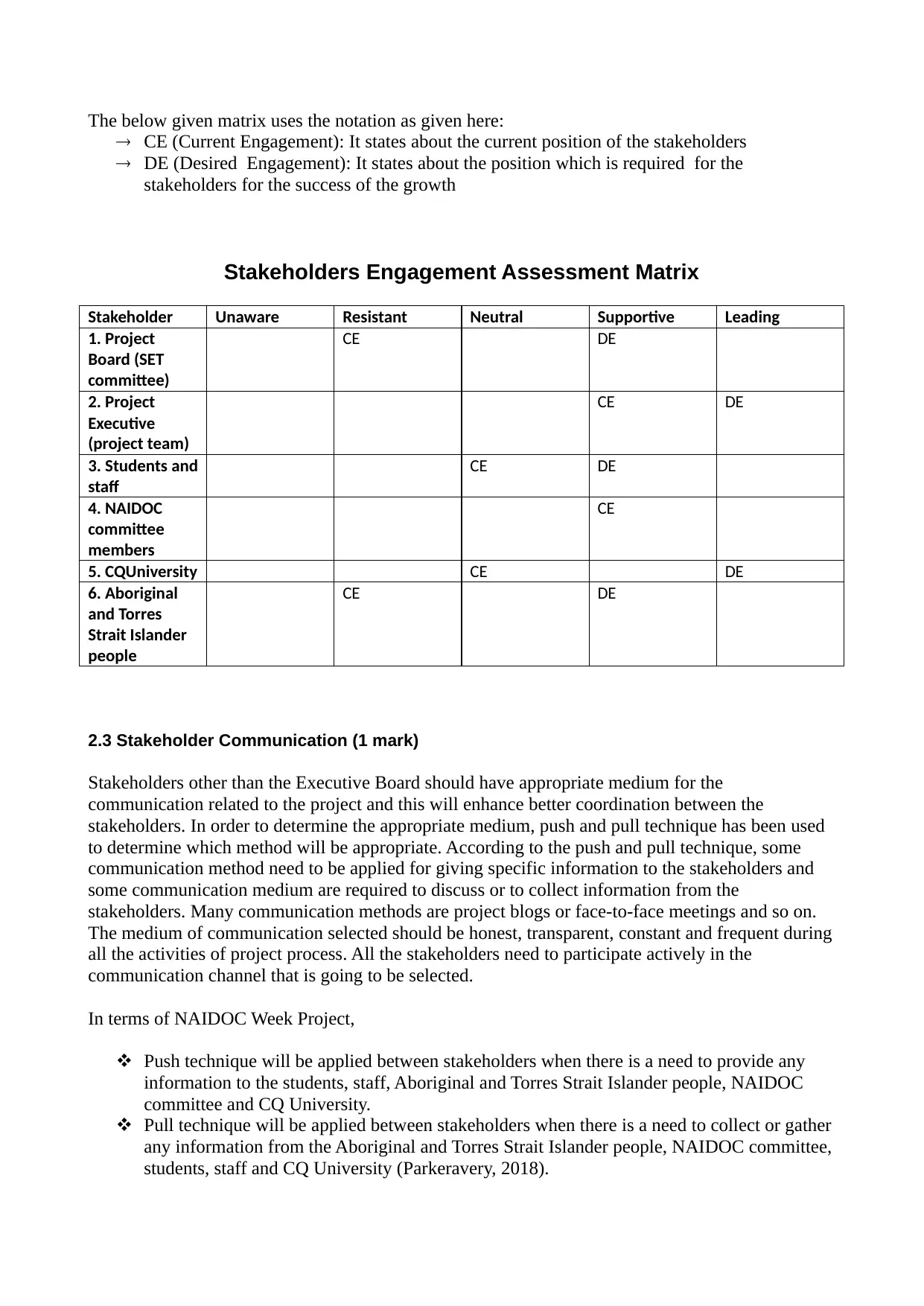
The below given matrix uses the notation as given here:
CE (Current Engagement): It states about the current position of the stakeholders
DE (Desired Engagement): It states about the position which is required for the
stakeholders for the success of the growth
Stakeholders Engagement Assessment Matrix
Stakeholder Unaware Resistant Neutral Supportive Leading
1. Project
Board (SET
committee)
CE DE
2. Project
Executive
(project team)
CE DE
3. Students and
staff
CE DE
4. NAIDOC
committee
members
CE
5. CQUniversity CE DE
6. Aboriginal
and Torres
Strait Islander
people
CE DE
2.3 Stakeholder Communication (1 mark)
Stakeholders other than the Executive Board should have appropriate medium for the
communication related to the project and this will enhance better coordination between the
stakeholders. In order to determine the appropriate medium, push and pull technique has been used
to determine which method will be appropriate. According to the push and pull technique, some
communication method need to be applied for giving specific information to the stakeholders and
some communication medium are required to discuss or to collect information from the
stakeholders. Many communication methods are project blogs or face-to-face meetings and so on.
The medium of communication selected should be honest, transparent, constant and frequent during
all the activities of project process. All the stakeholders need to participate actively in the
communication channel that is going to be selected.
In terms of NAIDOC Week Project,
Push technique will be applied between stakeholders when there is a need to provide any
information to the students, staff, Aboriginal and Torres Strait Islander people, NAIDOC
committee and CQ University.
Pull technique will be applied between stakeholders when there is a need to collect or gather
any information from the Aboriginal and Torres Strait Islander people, NAIDOC committee,
students, staff and CQ University (Parkeravery, 2018).
CE (Current Engagement): It states about the current position of the stakeholders
DE (Desired Engagement): It states about the position which is required for the
stakeholders for the success of the growth
Stakeholders Engagement Assessment Matrix
Stakeholder Unaware Resistant Neutral Supportive Leading
1. Project
Board (SET
committee)
CE DE
2. Project
Executive
(project team)
CE DE
3. Students and
staff
CE DE
4. NAIDOC
committee
members
CE
5. CQUniversity CE DE
6. Aboriginal
and Torres
Strait Islander
people
CE DE
2.3 Stakeholder Communication (1 mark)
Stakeholders other than the Executive Board should have appropriate medium for the
communication related to the project and this will enhance better coordination between the
stakeholders. In order to determine the appropriate medium, push and pull technique has been used
to determine which method will be appropriate. According to the push and pull technique, some
communication method need to be applied for giving specific information to the stakeholders and
some communication medium are required to discuss or to collect information from the
stakeholders. Many communication methods are project blogs or face-to-face meetings and so on.
The medium of communication selected should be honest, transparent, constant and frequent during
all the activities of project process. All the stakeholders need to participate actively in the
communication channel that is going to be selected.
In terms of NAIDOC Week Project,
Push technique will be applied between stakeholders when there is a need to provide any
information to the students, staff, Aboriginal and Torres Strait Islander people, NAIDOC
committee and CQ University.
Pull technique will be applied between stakeholders when there is a need to collect or gather
any information from the Aboriginal and Torres Strait Islander people, NAIDOC committee,
students, staff and CQ University (Parkeravery, 2018).
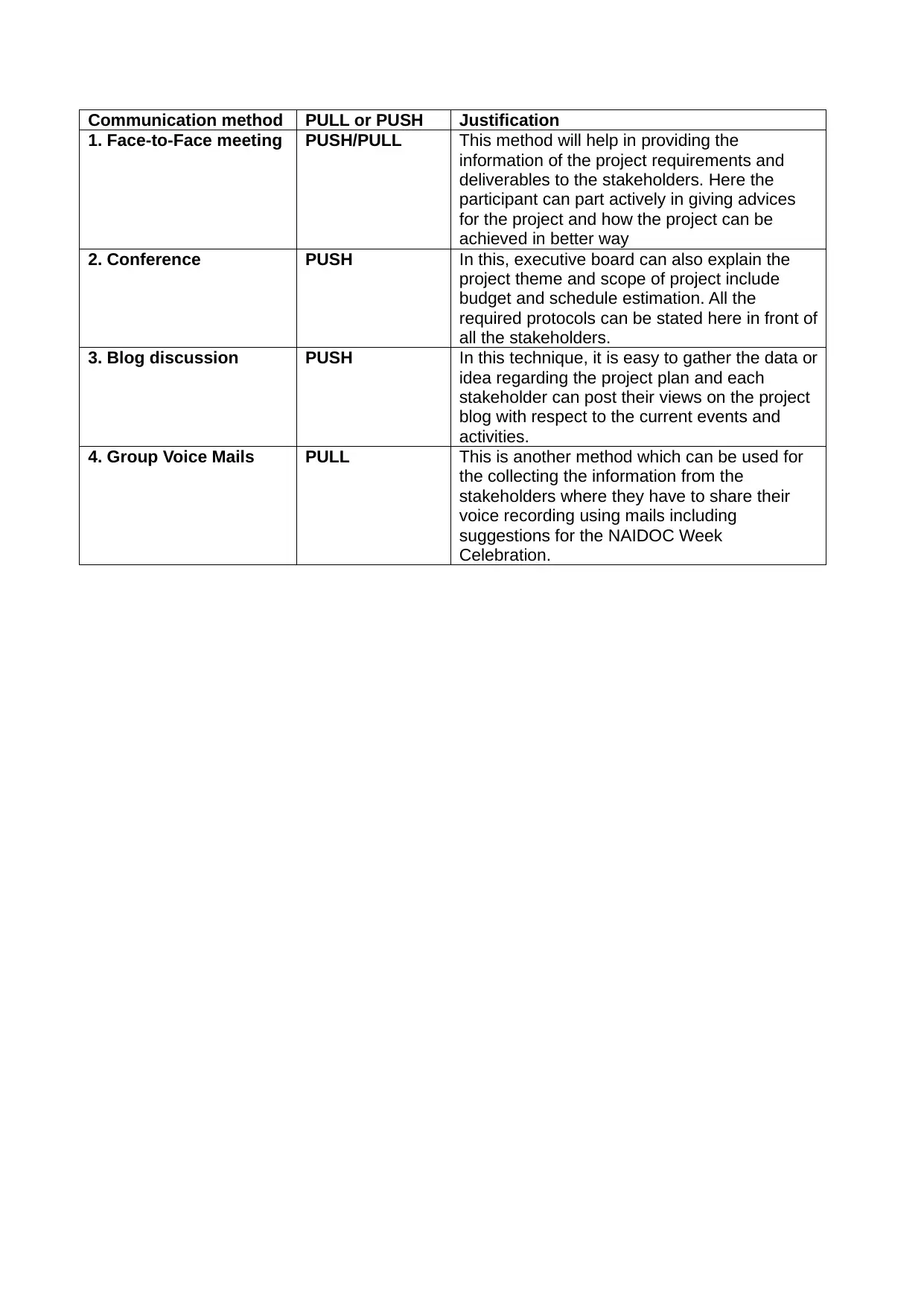
Communication method PULL or PUSH Justification
1. Face-to-Face meeting PUSH/PULL This method will help in providing the
information of the project requirements and
deliverables to the stakeholders. Here the
participant can part actively in giving advices
for the project and how the project can be
achieved in better way
2. Conference PUSH In this, executive board can also explain the
project theme and scope of project include
budget and schedule estimation. All the
required protocols can be stated here in front of
all the stakeholders.
3. Blog discussion PUSH In this technique, it is easy to gather the data or
idea regarding the project plan and each
stakeholder can post their views on the project
blog with respect to the current events and
activities.
4. Group Voice Mails PULL This is another method which can be used for
the collecting the information from the
stakeholders where they have to share their
voice recording using mails including
suggestions for the NAIDOC Week
Celebration.
1. Face-to-Face meeting PUSH/PULL This method will help in providing the
information of the project requirements and
deliverables to the stakeholders. Here the
participant can part actively in giving advices
for the project and how the project can be
achieved in better way
2. Conference PUSH In this, executive board can also explain the
project theme and scope of project include
budget and schedule estimation. All the
required protocols can be stated here in front of
all the stakeholders.
3. Blog discussion PUSH In this technique, it is easy to gather the data or
idea regarding the project plan and each
stakeholder can post their views on the project
blog with respect to the current events and
activities.
4. Group Voice Mails PULL This is another method which can be used for
the collecting the information from the
stakeholders where they have to share their
voice recording using mails including
suggestions for the NAIDOC Week
Celebration.
⊘ This is a preview!⊘
Do you want full access?
Subscribe today to unlock all pages.

Trusted by 1+ million students worldwide
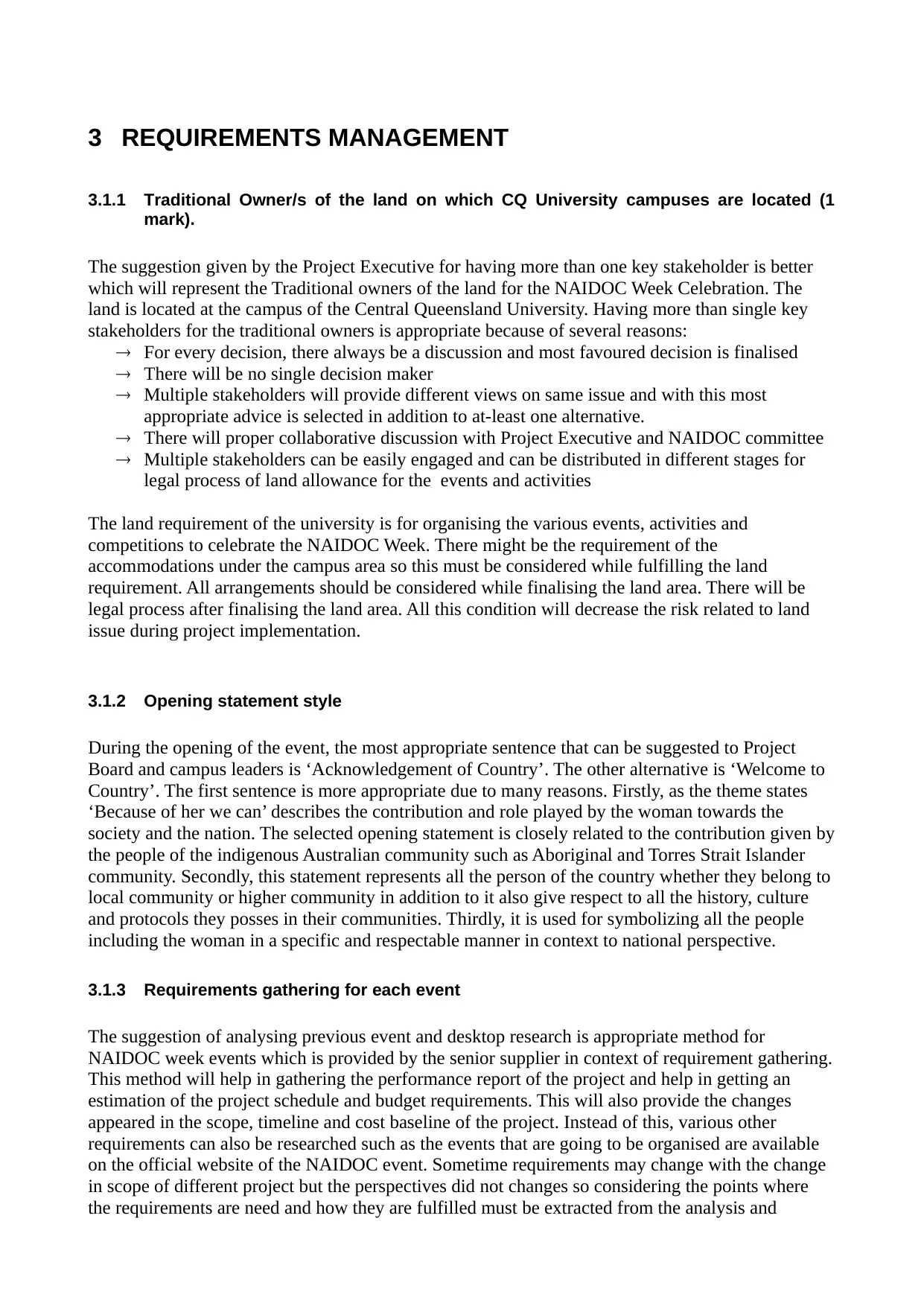
3 REQUIREMENTS MANAGEMENT
3.1.1 Traditional Owner/s of the land on which CQ University campuses are located (1
mark).
The suggestion given by the Project Executive for having more than one key stakeholder is better
which will represent the Traditional owners of the land for the NAIDOC Week Celebration. The
land is located at the campus of the Central Queensland University. Having more than single key
stakeholders for the traditional owners is appropriate because of several reasons:
For every decision, there always be a discussion and most favoured decision is finalised
There will be no single decision maker
Multiple stakeholders will provide different views on same issue and with this most
appropriate advice is selected in addition to at-least one alternative.
There will proper collaborative discussion with Project Executive and NAIDOC committee
Multiple stakeholders can be easily engaged and can be distributed in different stages for
legal process of land allowance for the events and activities
The land requirement of the university is for organising the various events, activities and
competitions to celebrate the NAIDOC Week. There might be the requirement of the
accommodations under the campus area so this must be considered while fulfilling the land
requirement. All arrangements should be considered while finalising the land area. There will be
legal process after finalising the land area. All this condition will decrease the risk related to land
issue during project implementation.
3.1.2 Opening statement style
During the opening of the event, the most appropriate sentence that can be suggested to Project
Board and campus leaders is ‘Acknowledgement of Country’. The other alternative is ‘Welcome to
Country’. The first sentence is more appropriate due to many reasons. Firstly, as the theme states
‘Because of her we can’ describes the contribution and role played by the woman towards the
society and the nation. The selected opening statement is closely related to the contribution given by
the people of the indigenous Australian community such as Aboriginal and Torres Strait Islander
community. Secondly, this statement represents all the person of the country whether they belong to
local community or higher community in addition to it also give respect to all the history, culture
and protocols they posses in their communities. Thirdly, it is used for symbolizing all the people
including the woman in a specific and respectable manner in context to national perspective.
3.1.3 Requirements gathering for each event
The suggestion of analysing previous event and desktop research is appropriate method for
NAIDOC week events which is provided by the senior supplier in context of requirement gathering.
This method will help in gathering the performance report of the project and help in getting an
estimation of the project schedule and budget requirements. This will also provide the changes
appeared in the scope, timeline and cost baseline of the project. Instead of this, various other
requirements can also be researched such as the events that are going to be organised are available
on the official website of the NAIDOC event. Sometime requirements may change with the change
in scope of different project but the perspectives did not changes so considering the points where
the requirements are need and how they are fulfilled must be extracted from the analysis and
3.1.1 Traditional Owner/s of the land on which CQ University campuses are located (1
mark).
The suggestion given by the Project Executive for having more than one key stakeholder is better
which will represent the Traditional owners of the land for the NAIDOC Week Celebration. The
land is located at the campus of the Central Queensland University. Having more than single key
stakeholders for the traditional owners is appropriate because of several reasons:
For every decision, there always be a discussion and most favoured decision is finalised
There will be no single decision maker
Multiple stakeholders will provide different views on same issue and with this most
appropriate advice is selected in addition to at-least one alternative.
There will proper collaborative discussion with Project Executive and NAIDOC committee
Multiple stakeholders can be easily engaged and can be distributed in different stages for
legal process of land allowance for the events and activities
The land requirement of the university is for organising the various events, activities and
competitions to celebrate the NAIDOC Week. There might be the requirement of the
accommodations under the campus area so this must be considered while fulfilling the land
requirement. All arrangements should be considered while finalising the land area. There will be
legal process after finalising the land area. All this condition will decrease the risk related to land
issue during project implementation.
3.1.2 Opening statement style
During the opening of the event, the most appropriate sentence that can be suggested to Project
Board and campus leaders is ‘Acknowledgement of Country’. The other alternative is ‘Welcome to
Country’. The first sentence is more appropriate due to many reasons. Firstly, as the theme states
‘Because of her we can’ describes the contribution and role played by the woman towards the
society and the nation. The selected opening statement is closely related to the contribution given by
the people of the indigenous Australian community such as Aboriginal and Torres Strait Islander
community. Secondly, this statement represents all the person of the country whether they belong to
local community or higher community in addition to it also give respect to all the history, culture
and protocols they posses in their communities. Thirdly, it is used for symbolizing all the people
including the woman in a specific and respectable manner in context to national perspective.
3.1.3 Requirements gathering for each event
The suggestion of analysing previous event and desktop research is appropriate method for
NAIDOC week events which is provided by the senior supplier in context of requirement gathering.
This method will help in gathering the performance report of the project and help in getting an
estimation of the project schedule and budget requirements. This will also provide the changes
appeared in the scope, timeline and cost baseline of the project. Instead of this, various other
requirements can also be researched such as the events that are going to be organised are available
on the official website of the NAIDOC event. Sometime requirements may change with the change
in scope of different project but the perspectives did not changes so considering the points where
the requirements are need and how they are fulfilled must be extracted from the analysis and
Paraphrase This Document
Need a fresh take? Get an instant paraphrase of this document with our AI Paraphraser
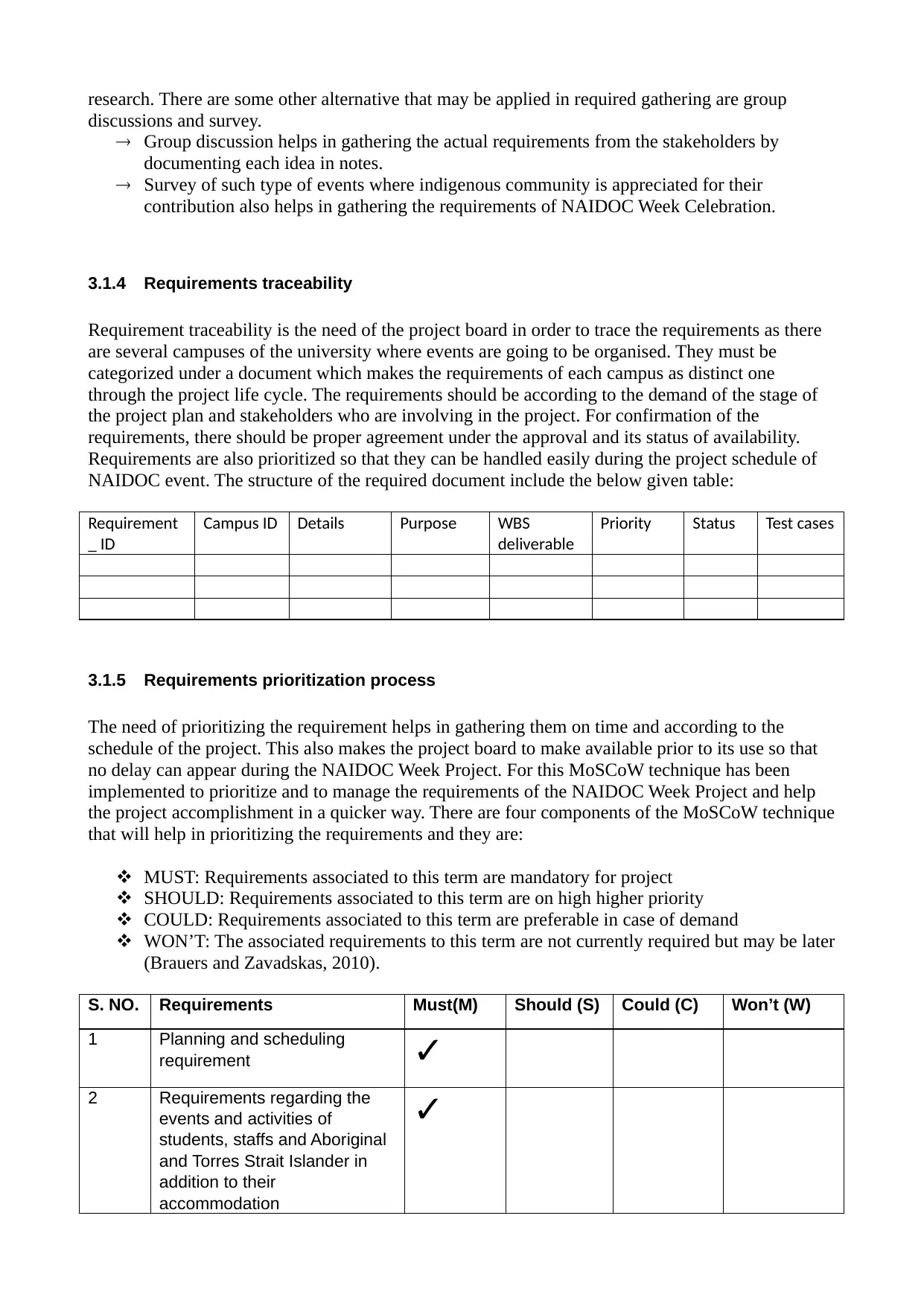
research. There are some other alternative that may be applied in required gathering are group
discussions and survey.
Group discussion helps in gathering the actual requirements from the stakeholders by
documenting each idea in notes.
Survey of such type of events where indigenous community is appreciated for their
contribution also helps in gathering the requirements of NAIDOC Week Celebration.
3.1.4 Requirements traceability
Requirement traceability is the need of the project board in order to trace the requirements as there
are several campuses of the university where events are going to be organised. They must be
categorized under a document which makes the requirements of each campus as distinct one
through the project life cycle. The requirements should be according to the demand of the stage of
the project plan and stakeholders who are involving in the project. For confirmation of the
requirements, there should be proper agreement under the approval and its status of availability.
Requirements are also prioritized so that they can be handled easily during the project schedule of
NAIDOC event. The structure of the required document include the below given table:
Requirement
_ ID
Campus ID Details Purpose WBS
deliverable
Priority Status Test cases
3.1.5 Requirements prioritization process
The need of prioritizing the requirement helps in gathering them on time and according to the
schedule of the project. This also makes the project board to make available prior to its use so that
no delay can appear during the NAIDOC Week Project. For this MoSCoW technique has been
implemented to prioritize and to manage the requirements of the NAIDOC Week Project and help
the project accomplishment in a quicker way. There are four components of the MoSCoW technique
that will help in prioritizing the requirements and they are:
MUST: Requirements associated to this term are mandatory for project
SHOULD: Requirements associated to this term are on high higher priority
COULD: Requirements associated to this term are preferable in case of demand
WON’T: The associated requirements to this term are not currently required but may be later
(Brauers and Zavadskas, 2010).
S. NO. Requirements Must(M) Should (S) Could (C) Won’t (W)
1 Planning and scheduling
requirement ✓
2 Requirements regarding the
events and activities of
students, staffs and Aboriginal
and Torres Strait Islander in
addition to their
accommodation
✓
discussions and survey.
Group discussion helps in gathering the actual requirements from the stakeholders by
documenting each idea in notes.
Survey of such type of events where indigenous community is appreciated for their
contribution also helps in gathering the requirements of NAIDOC Week Celebration.
3.1.4 Requirements traceability
Requirement traceability is the need of the project board in order to trace the requirements as there
are several campuses of the university where events are going to be organised. They must be
categorized under a document which makes the requirements of each campus as distinct one
through the project life cycle. The requirements should be according to the demand of the stage of
the project plan and stakeholders who are involving in the project. For confirmation of the
requirements, there should be proper agreement under the approval and its status of availability.
Requirements are also prioritized so that they can be handled easily during the project schedule of
NAIDOC event. The structure of the required document include the below given table:
Requirement
_ ID
Campus ID Details Purpose WBS
deliverable
Priority Status Test cases
3.1.5 Requirements prioritization process
The need of prioritizing the requirement helps in gathering them on time and according to the
schedule of the project. This also makes the project board to make available prior to its use so that
no delay can appear during the NAIDOC Week Project. For this MoSCoW technique has been
implemented to prioritize and to manage the requirements of the NAIDOC Week Project and help
the project accomplishment in a quicker way. There are four components of the MoSCoW technique
that will help in prioritizing the requirements and they are:
MUST: Requirements associated to this term are mandatory for project
SHOULD: Requirements associated to this term are on high higher priority
COULD: Requirements associated to this term are preferable in case of demand
WON’T: The associated requirements to this term are not currently required but may be later
(Brauers and Zavadskas, 2010).
S. NO. Requirements Must(M) Should (S) Could (C) Won’t (W)
1 Planning and scheduling
requirement ✓
2 Requirements regarding the
events and activities of
students, staffs and Aboriginal
and Torres Strait Islander in
addition to their
accommodation
✓

3 Documented notes during
project meetings and group
discussions
✓
4 Confirmation agreement of
land owners ✓
5 Session details of practising
the planned shedule ✓
project meetings and group
discussions
✓
4 Confirmation agreement of
land owners ✓
5 Session details of practising
the planned shedule ✓
⊘ This is a preview!⊘
Do you want full access?
Subscribe today to unlock all pages.

Trusted by 1+ million students worldwide
1 out of 22
Related Documents
Your All-in-One AI-Powered Toolkit for Academic Success.
+13062052269
info@desklib.com
Available 24*7 on WhatsApp / Email
![[object Object]](/_next/static/media/star-bottom.7253800d.svg)
Unlock your academic potential
Copyright © 2020–2025 A2Z Services. All Rights Reserved. Developed and managed by ZUCOL.




